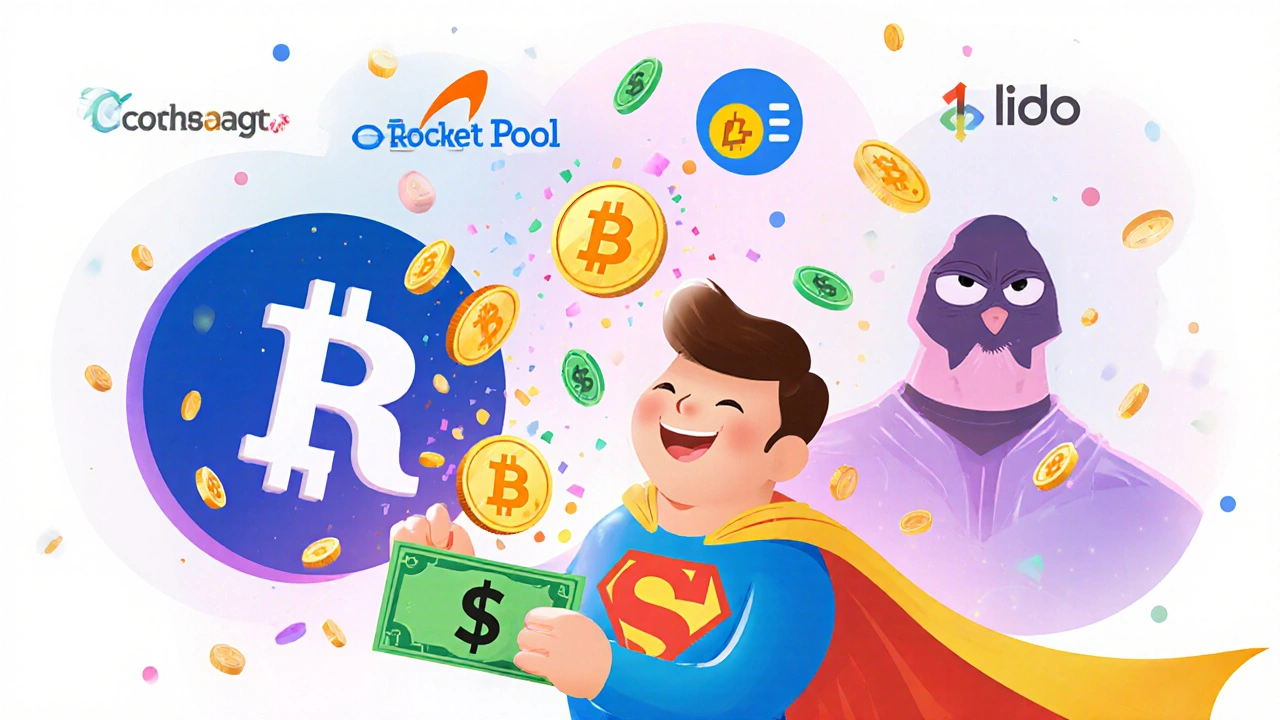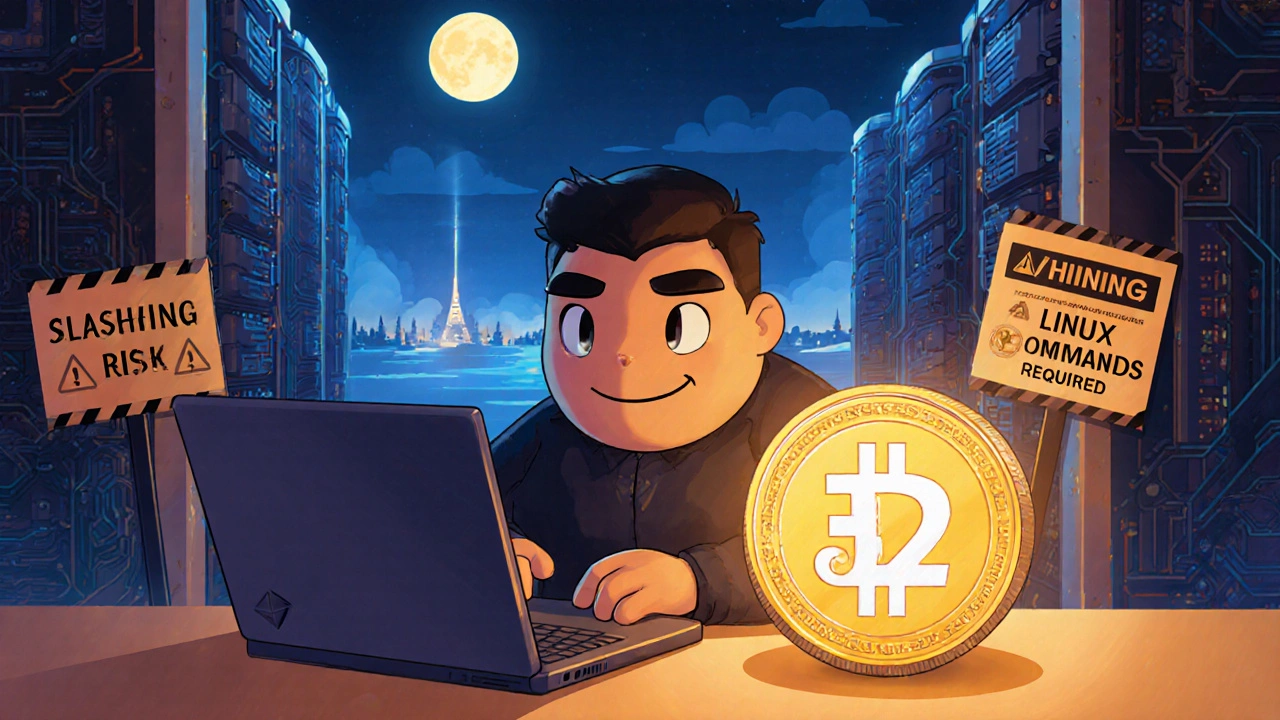Staking Pools vs Solo Staking: Which One Actually Makes Sense for You?
Imagine earning passive income just by holding ETH - no mining rigs, no electricity bills, no noise. That’s the promise of staking. But here’s the catch: you’ve got two paths. One is solo staking - running your own validator node with 32 ETH. The other is staking pools, where you throw in $10 or $100 and let someone else handle the tech. Which one’s better? It’s not about which is smarter. It’s about which fits you.
What Solo Staking Really Requires
Solo staking sounds powerful. You’re directly securing the Ethereum network. You get the full reward. No middlemen. But the reality? It’s not for everyone. You need 32 ETH - about $112,000 as of November 2025. That’s not a typo. Most people don’t have that kind of capital sitting around. Even if you do, you’re not done. You need a reliable computer: 4-core CPU, 16GB RAM, a 1TB SSD, and a stable internet connection that doesn’t blink. You need to know how to run Linux commands, set up firewalls, and monitor system logs. One mistake - a misconfigured update, a power outage, a forgotten backup - and you could lose part of your stake. Slashing penalties aren’t theoretical. In 2023, over 0.8% of solo validators lost ETH due to downtime or errors. That’s not a small number when you’re staking tens of thousands of dollars. And then there’s the waiting game. You can’t withdraw your ETH until the Shanghai upgrade in April 2023 - and even then, withdrawals are processed in queues. If the network is busy, you might wait days or weeks to get your money out. No liquidity. No flexibility. If you need cash for an emergency, you’re stuck.How Staking Pools Work (And Why They’re So Popular)
Staking pools fix the biggest problems of solo staking: capital, complexity, and liquidity. You can join with as little as $10. Platforms like Lido, Coinbase, and Kraken handle everything - the hardware, the software, the uptime. You get rewarded proportionally to your share. Easy. But here’s what most people don’t realize: you’re not staking ETH anymore. You’re staking a token that represents your ETH - like stETH or rsETH. These are liquid staking derivatives. They trade on exchanges, and you can use them in DeFi. That’s the big win. Need cash? Sell your stETH. It’s not ETH, but it’s close. The catch? Fees. Most pools take 10-15% of your rewards. Coinbase charges 25%. That eats into your returns. Solo stakers might earn 5.2% APY. Pool users? Around 4.5%. That gap adds up. Over a year, on $10,000 staked, you’re losing $70 just in fees. But here’s the trade-off: you’re also avoiding 73% of the risk. If your node goes down, you don’t get slashed. The pool absorbs it. You sleep better.Who Should Stake Solo?
Let’s be clear: solo staking is a technical hobby with financial upside. It’s not a set-and-forget investment. You need to care about blockchain infrastructure. You need to enjoy tinkering with servers. You need to be okay with long-term lock-up. If you’ve got 32 ETH, a spare computer, and you’ve spent time reading Ethereum’s official staking docs, then solo staking gives you the highest possible return and the most control. You’re not trusting anyone. You’re not relying on a company’s uptime. You’re part of the network’s backbone. That matters - especially if you believe in decentralization. But here’s the truth: only about 0.3% of Ethereum holders can realistically solo stake. The rest? They’re either waiting, pooling, or not staking at all. And that’s okay.
Who Should Use a Staking Pool?
If you’re a retail investor with 0.5 ETH or 5 ETH, staking pools are your only real option. You don’t need to know what a Geth client is. You don’t need to worry about disk space. You just connect your wallet, click “Stake,” and walk away. Pools are also better if you value liquidity. Want to move your staked ETH into a DeFi yield farm? Use your stETH. Need to cash out before the next upgrade? Sell your derivative token. No waiting. No queues. No headaches. And if you’re an institutional investor? Pools are mandatory. Regulators demand compliance. Custody solutions. Audits. Insurance. Coinbase and Kraken offer that. Solo staking? No one’s auditing your home server.The Centralization Problem
Here’s the uncomfortable truth: staking pools are making Ethereum less decentralized. As of Q3 2025, the top five staking providers control over 34.7% of all Ethereum validators. That’s a huge concentration of power. If one of them gets hacked, goes offline, or gets shut down by regulators, it could destabilize the whole network. Ethereum’s original vision was for thousands of independent nodes - not a handful of corporate services. That’s why researchers from the University of Zurich warn that pooled staking creates new attack vectors. The network is more secure because more people are staking. But it’s also more fragile because control is concentrated. The good news? Mid-sized pools - between 10,000 and 50,000 validators - strike the best balance. They’re big enough to be reliable, small enough to avoid being too dominant. Lido and Coinbase are huge. But services like Rocket Pool and Stakewise are smaller and more community-focused. Choosing a mid-sized pool reduces your exposure to centralization risks.Real User Experiences
Reddit’s r/ethstaker community has over 247,000 members. Scroll through it, and you’ll see two types of posts. One is from someone who spent 20 hours setting up their node, got their first reward, and posted a screenshot with a “Worth it” caption. The other is from someone who joined Lido expecting 4.5% APY, got 3.8%, and is confused why. The answer? Unstaking queues. When too many people want to withdraw, the system slows down. Rewards get delayed. The APY drops temporarily. Trustpilot reviews for Coinbase Staking are mostly positive - 4.2 out of 5 - but the complaints are consistent: “25% fee is too high,” “took 72 hours to get my first reward,” “no transparency on how rewards are calculated.” On the flip side, solo stakers who succeed rarely complain. They’re proud. They built something. But the ones who fail? They’re silent. They lost ETH. They don’t post about it.The Future of Staking
Ethereum’s roadmap is changing everything. The Dencun upgrade in March 2024 improved staking efficiency by nearly 20%. The Verkle tree upgrade in 2026 will cut node storage needs by 65%. That means solo staking will get easier - cheaper hardware, less bandwidth, lower barriers. Then there’s the Veronica upgrade in late 2026. It introduces single-slot finality, which could reduce slashing risks by 42%. That’s huge. It means your node won’t get punished as harshly for a brief outage. Meanwhile, regulators are watching. The EU’s MiCA rules, active since December 2024, limit how big any single staking pool can get. The SEC is still deciding whether staking services are securities. That uncertainty could shake up the market.Final Decision: Pick Based on Your Reality
So which is better? Solo staking or staking pools? If you have 32 ETH, technical skills, patience, and you believe in running your own node - go solo. You’ll earn more, and you’ll help keep Ethereum decentralized. If you have less than that, don’t want to manage a server, need liquidity, or just want to earn rewards without stress - use a pool. Pick a mid-sized provider like Rocket Pool or Stakewise. Avoid the top 3 if you care about decentralization. There’s no universal winner. The best choice depends on your money, your tech comfort, and your goals. Most people don’t realize that staking isn’t about maximizing returns. It’s about aligning your participation with your capacity. Do what fits your life - not what sounds cool.Can I stake less than 32 ETH?
Yes, but not through solo staking. Solo staking requires exactly 32 ETH per validator. If you have less, you must use a staking pool. Platforms like Lido, Coinbase, and Kraken let you stake as little as $10. Your ETH is pooled with others to meet the 32 ETH requirement, and you receive proportional rewards.
Are staking pools safe?
Most major staking pools are secure, but they’re not risk-free. You’re trusting a company to run your validator properly. If they’re hacked, mismanaged, or go offline, you could lose rewards or face slashing penalties indirectly. Liquid staking tokens like stETH can also trade at a discount to ETH. Stick to well-established, audited providers like Coinbase, Kraken, or Rocket Pool. Avoid obscure pools with little transparency.
Which gives higher returns: solo staking or staking pools?
Solo staking typically offers higher returns - around 5.2% APY - because there are no middlemen fees. Staking pools usually offer 4.5% APY after fees of 10-25%. However, solo stakers face higher risks of slashing penalties, which can wipe out weeks or months of rewards. For most people, the slightly lower yield of pools is worth the reduced risk and convenience.
Can I withdraw my staked ETH anytime?
With solo staking, you can’t withdraw your ETH until you request a withdrawal - and even then, the network processes them in queues. It can take days or weeks. With staking pools, you get liquid tokens like stETH that you can sell or trade anytime on exchanges. But remember: stETH isn’t ETH. It trades at a slight discount (around 2.1% as of late 2025), so you won’t get full value if you sell immediately.
Is solo staking worth the effort?
Only if you’re technically skilled and have the time to maintain a validator 24/7. You’ll need Linux knowledge, hardware setup, and constant monitoring. Most people find the 15-20 hours of setup and 2-3 hours weekly maintenance too much. For the average user, the rewards don’t justify the hassle. Solo staking is for enthusiasts, not investors.
What’s the biggest risk in staking?
The biggest risk depends on your path. For solo stakers, it’s slashing - losing ETH due to downtime or misconfiguration. For pool users, it’s counterparty risk - the pool going offline, getting hacked, or changing fees unexpectedly. Both carry risk, but pool users are shielded from direct slashing. The safest approach is using a reputable, mid-sized pool with transparent operations.




